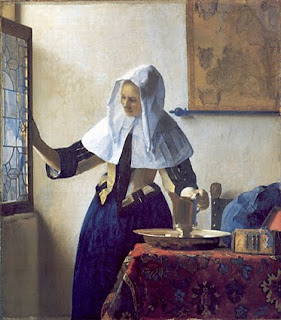











Deploying light as an active agent in art making is one of the fundamental basis for expression and meaning. Orchestrating both lights and shadows as active spaces in a composition begins to indicate a subjective perspective. Clearly choices are revealed, through illuminating presence and darken absence, as to what is important - object, location, time, narrative. It is the interplay of these two forces (shadow and darkness are not somehow lesser or simply defined by the absence of light, but rather are an elemental force, the diametric opposite, that yield and advance in balance with light) that create an overall tone. Below we see examples of how some artists from various mediums have used light to portray the figure for their own purposes.
 In the photo of President Obama we see an ambient light, not too powerful or dramatic. It tries to convey a sense of integrity, strength etc. Presidents are always cast in a light that will not be overt, but more timeless, more classical.
In the photo of President Obama we see an ambient light, not too powerful or dramatic. It tries to convey a sense of integrity, strength etc. Presidents are always cast in a light that will not be overt, but more timeless, more classical. A John McCain Photo from a magazine article pre -Election. The photographer got in a lot of trouble afterwards. From the vantage point and dramatic lighting we can see a subjective perspective of the person. McCain is presented as an overlord, ominous figure, clearly not a flattering portrayal. Notice the light from below and shadow up and behind.
A John McCain Photo from a magazine article pre -Election. The photographer got in a lot of trouble afterwards. From the vantage point and dramatic lighting we can see a subjective perspective of the person. McCain is presented as an overlord, ominous figure, clearly not a flattering portrayal. Notice the light from below and shadow up and behind. In this example of Jesus Christ, the light is eminating from within. It is a supernatural light that radiates softly outwards giving the sense of purity, kindness, godliness etc.
In this example of Jesus Christ, the light is eminating from within. It is a supernatural light that radiates softly outwards giving the sense of purity, kindness, godliness etc. In this example we see a frame from the Blair Witch Project, a more Baroque use of light, the figure dissolves into darkness. This use of lighting enhances the terror aspect of the subject and provides an environment for the emotion of the film- terror.
In this example we see a frame from the Blair Witch Project, a more Baroque use of light, the figure dissolves into darkness. This use of lighting enhances the terror aspect of the subject and provides an environment for the emotion of the film- terror. In this example we see an image from Sin City, by Frank Miller. Clearly the graphic use of light enhances the drama and grittiness of the content of the graphic novel. Notice the use of silohuette and how the darkness enters the figure.
In this example we see an image from Sin City, by Frank Miller. Clearly the graphic use of light enhances the drama and grittiness of the content of the graphic novel. Notice the use of silohuette and how the darkness enters the figure. Again we see a similar approach in Miller's Dark Knight novel. Batman, a character who walks the line between light and shadow (metaphorically), is displayed in that context visually.
Again we see a similar approach in Miller's Dark Knight novel. Batman, a character who walks the line between light and shadow (metaphorically), is displayed in that context visually. In this example by Luc Tuymans we see a portrait with a strong light casting strong shadows. As is typical in his palette, we notice a slight wan quality or paleness. In the following example, we see another painting of Tuymans, in which the contrast is even more obliterated and we get an overexposed light quality. The sense is that light (usually used to illuminate, give form to objects) is overexposured and hints at the destructive power of light as it dissolves away detail and form.
In this example by Luc Tuymans we see a portrait with a strong light casting strong shadows. As is typical in his palette, we notice a slight wan quality or paleness. In the following example, we see another painting of Tuymans, in which the contrast is even more obliterated and we get an overexposed light quality. The sense is that light (usually used to illuminate, give form to objects) is overexposured and hints at the destructive power of light as it dissolves away detail and form.
 Rembrandt is known for his Baroque use of light and often used its narrative potential. In this example we see a portrait of the artist and the light hints at his interior space, a place of brooding assuredness. The colors indicate candle light or evening light.
Rembrandt is known for his Baroque use of light and often used its narrative potential. In this example we see a portrait of the artist and the light hints at his interior space, a place of brooding assuredness. The colors indicate candle light or evening light. Working in Delft during troubled times in Europe, Vermeer crafted these paintings. Exquisite light delicately falling inside on the working people. They convey a pure, cleansing light, perhaps early morning and definitely Northern European light. All expressed by his choice of light, color, setting etc.
Working in Delft during troubled times in Europe, Vermeer crafted these paintings. Exquisite light delicately falling inside on the working people. They convey a pure, cleansing light, perhaps early morning and definitely Northern European light. All expressed by his choice of light, color, setting etc.

